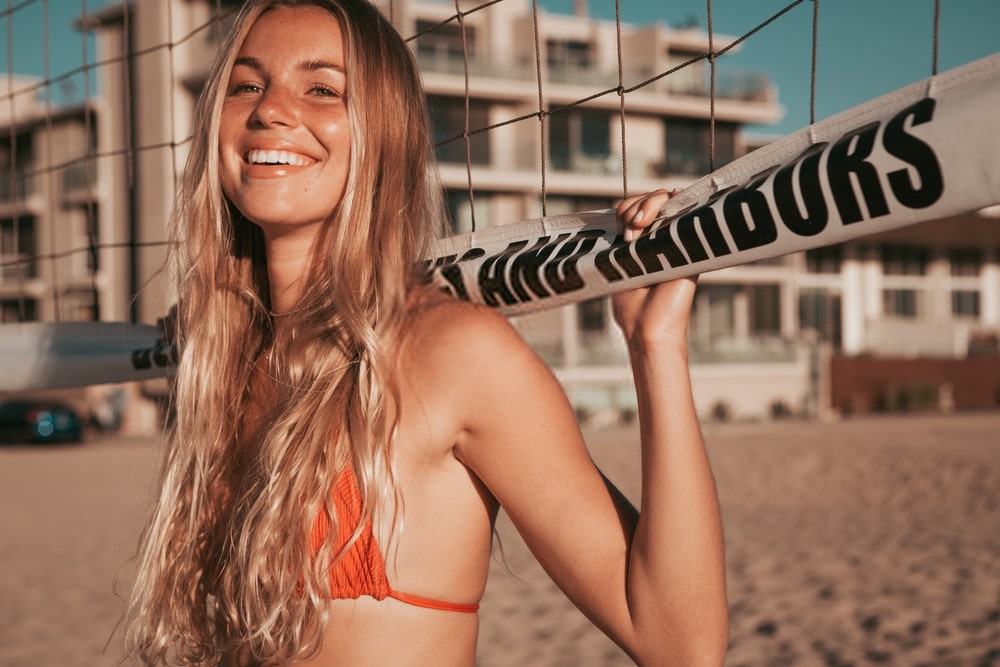Tanning is all the rage right now. According to a study, people with tanned skin look hotter than the ones who do not have a tan. Millions of people are crazy about getting bronzed, and if you’re one of them, welcome to the club.
Now, there are many ways to get tanned, but basking in the sun is by far the most popular choice. The catch? Overexposure to the sun can pose some health concerns such as sunburns, hyperpigmentation, and whatnot. Therefore, it’s imperative that you avoid prolonged sun exposure.
But if you spend too little time out in the sun, chances are you won’t get tanned at all. So, what can you do? Well, you just need to do is arm yourself with proper knowledge and you should be good to go!
For example, you should know when is the best time to tan safely, how much time to spend in the sun, understand the risks of UV rays, and the importance of wearing sunscreen for that matter. Since you’re here, it’s obvious that you’re looking for all these answers.
Before we begin, it’s important that you understand that tanning results vary from person to person. Some people achieve that sun-kissed look faster than the others.
Anyway, we’re here to help you get a dark tan faster. Ahead, we discuss a few tips to maximize the results. Scroll on to learn more!
Best Hours to Tan
Sun tanning is the result of exposure to UVA radiation. If you’re someone who is looking to get results fast, tanning during peak hours would be your best bet. That is to say, you should tan outside when the sun’s UVA rays are at their strongest.
At noon, the earth is at the closest distance to the sun. And this is the time when you’ll get maximum results. So, for a dark tan in the least amount of time possible, it’s best that you go outside between 10 a.m. to 2 p.m.
Don’t forget to put on sunblock to avoid damage to your skin. Also, choose a broad-spectrum sunscreen that provides protection against both UVA and UVB rays.
Keep note that these are the best hours to get the darkest tan, not the safest. During these hours, the risk of getting a sunburn is high. If you want to get tanned safely, then you should consider going in the sun before 10 a.m. or after 4 p.m.
The American Cancer Society advises limiting sun exposure between 10 a.m to 4 p.m. More importantly, if you have sensitive skin, you should avoid getting tanned during peak hours.
Tips to Get a Tan Quickly
Apart from tanning during peak hours, there are other things you should keep in mind to get a tan faster. Let’s talk about some of these tips:
Wear Low SPF Sunscreen
For someone looking to get results fast, you should wear a low SPF sunscreen. A sunblock or body lotion with a high SPF level will prevent you from getting tan. Ideally, you should go with an SPF level of 25 to 30.
An SPF 30 sunscreen is enough to protect you from the risks of cancer, sunburn, etc. At the same time, you will be able to achieve that golden glow.
Apply Natural Oils
If you have a good base tan, you should consider applying natural oils such as coconut oil, avocado oil, olive oil, sunflower oil, etc. These oils are natural tan enhancers and will maximize your tanning results.
Change Positions
An uneven tan doesn’t look good at all. That’s why it’s important that you keep turning your body over frequently. This will ensure that you get a more even and natural tan. Additionally, it will prevent you from burning one part of your body.
Make sure you give equal time to all your sides. You also need to keep moving your arms and legs to avoid unpleasant tan lines.
Exfoliate Your Skin
In order to make your tan last longer, it’s good that you exfoliate your skin before tanning. It’s very likely that your tanned skin will peel off quickly if it hasn’t been exfoliated. You can use olive oil, peppermint, and sugar scrub for doing that. Or you can body exfoliators online.
Face the Sun Directly
The earth revolves around the sun. As a result, our position with respect to the sun keeps changing. It’s important that you position yourself accordingly to get the darkest tan really quickly. It’s okay to take a break in between if you can’t stand the intense heat.
Wear As Little Clothes As Possible
For the best results, wear as little clothes as possible. If possible, wear a strapless top. This way you can ensure that you don’t get those weird lines. On top of that, your tan will look more natural and pleasing.
Eat Tomatoes
Tomatoes are rich in lycopene. Studies show that lycopene-rich foods can protect you from cutaneous photodamage. Guava, papaya, autumn olive, grapefruit, watermelon, gac, etc. are some other fruits that you can eat.
Reapply Sunscreen Every Two Hours
Many brands advertise long-lasting sun protection. That is simply not true. If you’re out in the sun, you should reapply SPF lotion every two hours. If you had contact with water, apply the lotion immediately especially if the lotion is not water-resistant.
Best Time to Tan Outside Safely

If you want to tan safely, then the best time would be before 10 a.m. and after 4 p.m. It’s obvious that you won’t get results fast during these hours. But the good news is that the UV rays are not that strong during these hours.
So, you’re much safer tanning during these hours. Dermatologists, cancer organizations, and skincare experts also advise that you should only consider tanning during these hours. They simply want you to avoid sun exposure when the sun’s rays are the strongest.
Keep in mind that it will take you much longer to develop a dark tan but it’s better that you play it safe. In addition, you can also avoid signs of early aging.
Just because you’ve chosen safe hours doesn’t mean that you won’t need SPF lotions. UV rays are still present and it’s crucial that you wear sunscreen even during those hours.
We often get asked what’s the best time to tan at the Beach. Well, tanning at the beach is no different than regular sun tanning. You will get the darkest tan between 10 a.m. to 2 p.m. But then again, these are not the safest hours.
How About Tanning Beds
Some people prefer tanning beds over sun tanning for a variety of reasons. It gives fast results and some people feel more comfortable using tanning beds. Then there are people who want to develop a base tan first and indoor tanning sessions serve the purpose really well.
Also, there are areas in the world that do not receive enough sunlight. In such cases, tanning beds make perfect sense.
On top of that, there is a reduced risk of getting cancer with indoor tanning sessions. Why? Because with sun tanning, you’re exposed to harmful UV rays for hours. However, with tanning beds, the process is faster and you’re exposed to UV rays for a lesser amount of time.
But take note that you’re still exposed to those harmful radiations. Also, the intensity of these radiations is high with tanning beds. Therefore, it’s important that you protect yourself from those rays. Make sure you use a high-quality indoor tanning lotion. Tanning sessions can dry out your skin.
Using an indoor tanning lotion will keep your skin moisturized, prevent premature aging, and greatly reduces the risk of cancer.
How Long Does it Take to Tan?
Tanning time is different for everyone. Some people develop a tan in only a few hours while others start to burn after a few minutes.
It all depends on the amount of melanin you have. Light skinned people have less melanin whereas people with dark skin tones have more melanin. People with fair skin tend to burn so easily. And they might find it hard to get tanned easily.
On the other hand, dark-skinned people can get tanning results in a matter of minutes or hours. As we said, it all depends on your skin tone. So, if you see your friend getting a darker tan than you when you spent the same amount of time, it could be that they have more melanin.
Tanning Risks
Sure, that sun-kissed look feels really nice. It feels great when everyone compliments you on your skin tone. Additionally, sunbathing can improve your mood to a great extent. But it’s important that you understand the risks of tanning especially if you skip sunscreens. Here are a few of them:
- Skin Cancer: The biggest risk of tanning is that you can develop skin cancer. Overexposure to the UV rays is the leading cause of Melanoma. Never ever go tanning without a broad-spectrum sunblock.
- Dehydration: Tanning can also cause dehydration and dry skin.
- Sunburns: Overexposure to the UV rays can cause your skin to burn and turn red. Sunburns can lead to skin cancer.
- Early Aging: UV rays penetrate your skin and alter your DNA. The damage to DNA leads to premature aging. Your skin loses elasticity and you get wrinkles, fine lines, etc.
Also: How long should you wait to shower after tanning?
Tanning Tips to Reduce Risks
Sure, there are a lot of risks involved. But if you’re careful, you can avoid those risks and still achieve that golden tan. Here are a few tanning tips for you:
Don’t Stay Out in the Sun for Long
You can reduce the risks to a great extent by limiting the time you stay out in the sun. It is much safer that way. This sunbathing calculator can help you determine how much time you can spend out in the sun.
Don’t Forget Sunscreen
As mentioned earlier, don’t forget to wear sunscreen. Make sure to reapply it every two hours. Don’t go for an SPF level of less than 25. Don’t miss any areas. Be sure to apply it on your feet, hairline, etc.
Wear Sunglasses
UV rays can also damage your eyes. Invest in sunglasses to protect your eyes. Make sure your glasses offer 100% UV protection.
Drink Water
Drink lots of water, especially when you’re out in the sun. Failure in doing so will result in dehydration, which is not good for your health or your skin.
Avoid Alcohol
When you’re drinking alcohol, you might not be able to feel sunburn. Therefore, don’t drink alcohol when you’re out in the sun. Also, you would want to avoid sleeping when you’re tanning.
Conclusion
When you’re feeling depressed, tanning can improve your mood. And it’s possible to get a tanned skin safely if you know what you’re doing. The key is to familiarize yourself with the whole process and you can get great results. You have to be careful or you might put yourself in trouble.
Understand the whole process first and learn about the risks involved. Once you understand that, you’re good to go. If you have any questions about tanning, feel free to ask in the comments below.

